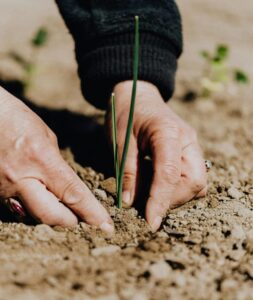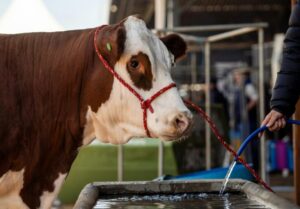Introduction
Farming is only one part of the process which gets food onto people’s plates. Agricultural production leads on to packaging, transporting and marketing/selling. There are many places for inefficiencies and wastage. Supply chain management takes a look at all the links in this process.
Dr Tobias Doyer makes the case for co-operation and co-ordination as a way to increase benefits:
- reduced cost through specialisation
- improved synergistic performance
- increased information to support joint planning
- enhanced customer service
- reduced risk and uncertainty
- shared creativity
- improved competitive advantage
Vertical integration is another name given to extending the business to include upstream and downstream activities. Having various assets under one umbrella maximises value in the supply chain.
Certain aspects require advice from legal professionals to avoid what could be seen as uncompetitive behaviour potentially leading to trouble with the Competition Commission.
The farmer’s share of the consumer rand is shrinking. Primary production is the least profitable of all sectors in a value chain. Farmers can share in the profits made upstream through their own farmer-owned businesses. We should do this before we lose more farmers and the total production lands in the hands of a few large companies.
Source: Dr Koos Coetzee
Small-scale farmers
In the past, agriculture has been fragmented, with input suppliers, farmers, beneficiators, marketers, financiers, off takers, and consumers all seeing themselves as separate role players without responsibility for any other element of the value chain.
There is every argument to be made for small scale farmers to form buying and marketing groups.
- They can optimise their input costs and negotiate contracts with off takers. Such groups could operate at a regional rather than national level, and don’t need to be limited to one specific industry.
- South Africa’s geographic diversity means that many regions have a range of climatic conditions that would enable a variety of crops to be produced and then sold collectively to local retailers. In other words, grain, livestock, fruit, and vegetable farmers could work together to negotiate one contract to which they would all be suppliers. The retailers would get the product variety they need to attract consumers, and each farmer within a farming group would benefit from a stable supply contract.
- It may also be easier for the government to grant subsidies to collective farming structures instead of individuals.
- Banks prefer to fund small scale farmers through an umbrella organisation that takes responsibility for the group meeting its contract obligations.
- Having a retailer ring-fencing the bank’s risk by contracting to put the group’s products on its shelves makes such groups even more attractive.
Local retailers, like Walmart and Pick ‘n Pay, are paving the way through sourcing goods locally, directly from farmers. The onus now falls on these small scale farmers to make collaboration at their end of the value chain a success. This means upholding a consistent supply of quality products to retailers.
Source: adapted from the article “Small scale farmers must join forces to cash in on new trend toward local supply, processing and distribution” by Magna Carta Public Relations for Standard Bank.
There is a hotline to speed up government payments to Small Medium and Micro Enterprises (SMMEs). Business enterprises experiencing late payments of more than 30 days can call the hotline number on 0860 766 3729 for assistance.
Building a sustainable value chain has to involve all role players within the chain and any interventions at one level will have implications for the other stakeholders in the chain. Therefore, for any strategic interventions or investment to stimulate growth and speed up the transformation of the industry, for example the agri-parks, economic realities have to be taken into consideration with a clear understanding where in the chain the incentives and the investments need to be made.
Source: Bureau for Food and Agricultural Policy (BFAP)
Role players
View the Premium Listings below (scroll down or click on “Premium Listings” on the Table of Contents to the right).
Further reference:
- Some agricultural products such as flowers, meat, fruit and vegetables are vulnerable to supply chain disruptions. For contacts, refer to the relevant pages on Agribook. Similarly, other pages which apply include “Risk management and insurance” , “Exporting” and “Marketing” .
Websites and publications
- The Agricultural Commodity Value Profiles series on the Department of Agriculture website, www.nda.gov.za, explores the value chains of several agricultural commodities.
- The World Trade Organization (WTO) launched the Global Trade Data Portal to tackle supply chain disruptions and food security risks exacerbated by the COVID-19 pandemic and the Ukraine crisis. See https://globaltradedata.wto.org.
- The annual Africa Agriculture Status Report publication include information on the agri-food value chain. Find the latest one of the Internet.
- International Food Policy Research Institute (IFPRI). 2025. Global Food Policy Report 2025. Available at http://gfpr.ifpri.info.
- Watch the Nation in Conversation video (2023, May 18) “From sequence to interdependence: changing value chains.” at www.nationinconversation.co.za.
- Find the WWF SA report “Agri-Food Systems: Facts and Futures” (2019) at www.wwf.org.za/report/agrifood_systems
- Willoughby R & Gore T. 2018, June 21. “Ripe for Change: Ending human suffering in supermarket supply chains”. Oxfam. Available at www.oxfam.org/en/research/ripe-change
- Neves, MF 2017. Future of The Food Business: The FACTS The IMPACTS The ACTS. 2nd Edition. New Jersey: World Scientific. Visit www.favaneves.org.
- Louw M, Meyer F & Kirsten J. 2017. Vertical Price Transmission in South African Food Chains. BFAP. Available at www.bfap.co.za/vertical-price-transmission-in-south-african-food-chains/
- Find “Promoting agricultural global (regional) value chains in Africa” and other discussions on www.tralac.org, website of the Trade Law Centre (tralac).
- The Industrial Policy Action Plans (IPAPs) by the then Department of Trade & Industry usually identified aspects of the agri-food value chain for its interventions. The IPAPs cousin, the Agricultural Policy Action Plan (APAP) also looked at agricultural value chains as a way to effect interventions and improve agriculture’s performance. Find these documents on the Internet.
- A number of studies into supply chains can be found at www.namc.co.za, website of the National Agricultural Marketing Council (NAMC).
- Systems improvements and value-addition is identified as a priority area in the National Agricultural Research and Development Strategy document. This can be found at www.nda.gov.za.
- Various presentations are given at Agbiz events. Often these can be accessed for months afterwards at www.agbiz.co.za.
- Find the many options at www.bizcommunity.com. These include categories like agriculture and retail. A retail newsletter (which often covers agricultural products) is available too. Write to retailnews [at] bizcommunity.com.
- Commodity associations usually have material and studies relating to their chain.
- www.logistify.ai – “Logistify AI: AI Assistant for Global Supply Chain”
- Supply Chain Management Research blog – http://scmresearch.org
Some articles
- Van Innis J. 2025, April 10. “Beyond banks: How partnerships are unlocking capital for African agriculture”. Bizcommunity. Available at www.bizcommunity.com/article/beyond-banks-how-partnerships-are-unlocking-capital-for-african-agriculture-036275a
- Meyer P. 2023, November 2. “Managing the modern retail supply chain”. Bizcommunity. Available at www.bizcommunity.com/Article/196/183/243419.html
- See our blog “Reimagining the supply chain for resilience”.
- Lechman A. 2022, July 22. “Importers fighting a war on multiple fronts as crumbling infrastructure and load shedding threaten food safety”. IOL. Available at www.iol.co.za/business-report/companies/importers-fighting-a-war-on-multiple-fronts-as-crumbling-infrastructure-and-load-shedding-threaten-food-safety-c4db63be-9478-4688-8601-7c477bf0a2aa
- Sivalingum Z. 2022, April 6. “It’s time for businesses to reimagine the structure and value of supply chains”. Bizcommunity. Available at www.bizcommunity.com/Article/196/760/226780.html
- Zama Z. 2021, September 7. “Agricultural sector hostile to small farmers, report reveals”. 702. Available at www.702.co.za/articles/426543/agricultural-sector-hostile-to-small-farmers-report-reveals
- Singh A. 2021, July 14. “Evolving the supply chain to keep up with rising online retail demand”. Bizcommunity. Available at www.bizcommunity.com/Article/196/183/217922.html
- Boualam M. 2021, May 11. “The Circular Economy: New Business Models and Supply Chains Needed”. SCM Globe. Available at www.scmglobe.com/the-circular-economy-new-business-models-and-supply-chains-needed/
- Schroder E. 2021, February 4. “UN highlights vulnerabilities in global food chain”. Farmer’s Weekly. Available at www.farmersweekly.co.za/agri-news/world/un-highlights-vulnerabilities-in-global-food-chain/
- Fredericks R. 2019, September 25. “#FoodNextAfrica: Blockchain will simplify and transform supply chain traceability”. Bizcommunity. Available at www.bizcommunity.com/Article/196/741/195840.html
- Mndebele, M. 2019, April 12. “Young manager dreams of owning the whole chain, from farm to fork”. Food for Mzansi. Available at www.foodformzansi.co.za/movers-and-shakers-young-manager-dreams-of-owning-the-whole-chain-from-farm-to-fork/






